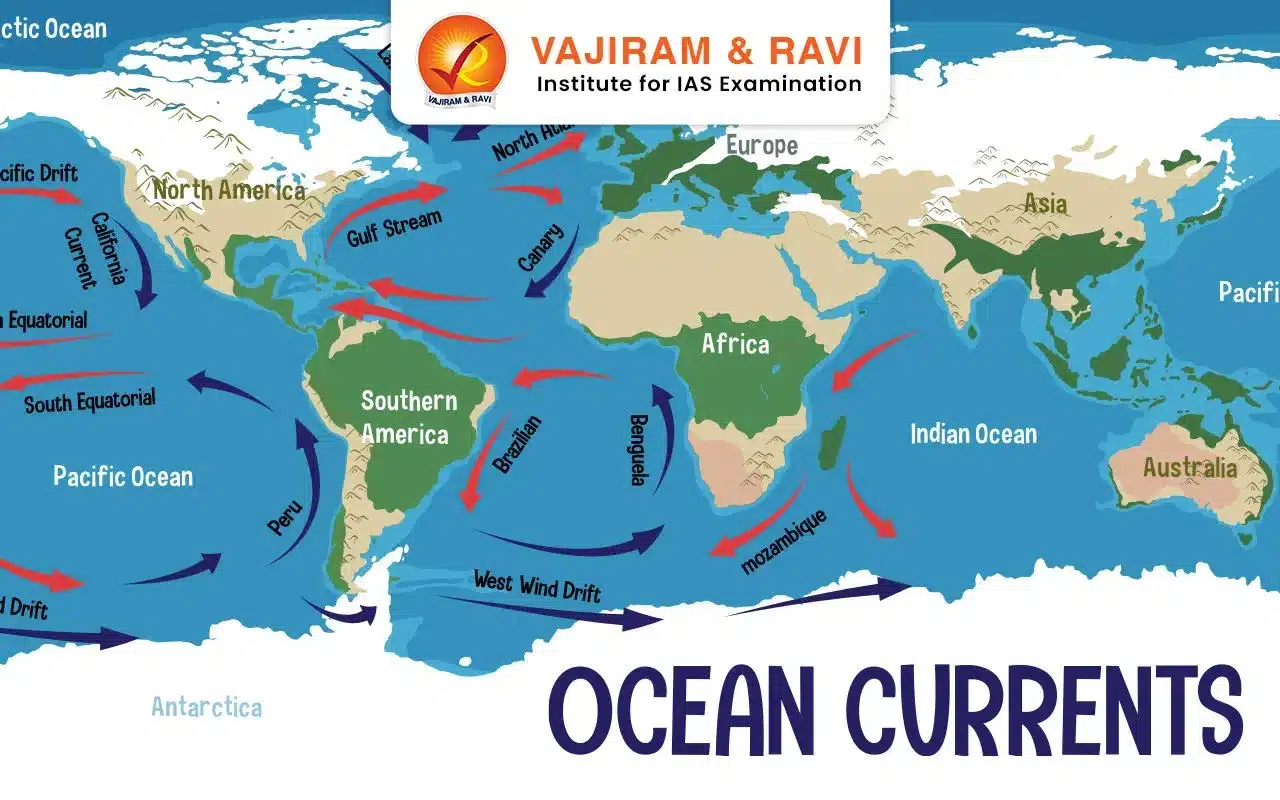Ocean currents are persistent and predictable flows of ocean water mass. These are driven by factors like wind, density gradients, Earth’s rotation, and landmasses that cause and influence their speed, direction and behaviour. These horizontal and vertical movements of ocean water are part of a large complex system that regulates heat transfer, shapes biodiversity patterns, and plays a vital role in Earth’s climate dynamics. Primarily, there are two types of ocean currents – warm and cold currents. These currents arrange themselves in such a way that they form the world’s major and minor oceanic gyres.
Ocean Currents Causes
Ocean currents are large-scale movements of seawater that flow in a specific direction. Several factors contribute to the formation of ocean currents:
- Causative factors:
- Density difference: Temperature and salinity variations lead to density differences in seawater, causing cooler and denser water to sink, and warmer and less dense water to rise, creating currents.
- Near the equator, solar heating causes the ocean water to expand, resulting in higher sea levels – approximately 8 cm higher than in mid-latitudes. This slight gradient causes the water to flow downslope, typically from east to west.
- Higher salinity increases water density. For example, in the Mediterranean Sea, high evaporation rates increase salinity, causing dense water to sink and flow out into the Atlantic Ocean through the Strait of Gibraltar, forming the Mediterranean Outflow Water.
- Wind: Winds blowing over the ocean’s surface drag the water, causing it to move. Friction between wind and water affects the magnitude and direction of currents. Examples:
- Indian Ocean currents: During the summer monsoon (June to September), strong southwesterly winds drive the Somali Current northeastward along the East African coast. In winter (December to February), the current reverses direction due to the northeast monsoon winds.
- The North and South Equatorial Currents in the Pacific and Atlantic Oceans are driven by the trade winds.
- Gravity: Differences in the gravitational pull due to the Earth’s rotation and the presence of landmasses can influence the movement of water masses, contributing to ocean currents.
- Tides: The gravitational forces exerted by the Moon and Sun cause tidal currents, which can interact with other currents and influence their behaviour.
- Density difference: Temperature and salinity variations lead to density differences in seawater, causing cooler and denser water to sink, and warmer and less dense water to rise, creating currents.
- Influencing factors:
- Local topography: The shape and depth of the ocean floor, as well as the presence of landmasses, can affect the direction and strength of currents.
- For example, the North Equatorial Current splits into two after reaching the South American landmass.
- Coriolis effect: The Coriolis effect, caused by the Earth’s rotation, deflects water movement to the right in the Northern Hemisphere and the left in the Southern Hemisphere.
- Local topography: The shape and depth of the ocean floor, as well as the presence of landmasses, can affect the direction and strength of currents.
Ocean Currents Types
Ocean currents are classified on various dimensions, such as speed, depth, temperature, etc.
- Types based on velocity: Ocean currents can be classified as drifts, currents, and streams in the order of velocity.
- Drifts are the movement of surface water of low velocity.
- Example: North Atlantic drift.
- Currents are faster than drifts.
- Example: Labrador current.
- Streams are larger masses of water moving in a definite direction and much greater velocity than drifts and currents.
- Example: Gulf Stream.
- Drifts are the movement of surface water of low velocity.
- Based on depth:
- Surface currents: These comprise about 10% of the ocean water, occupying the upper 400 meters.
- Surface currents are mainly powered by wind patterns and are easily observable.
- Deep-water currents: Constituting the remaining 90%, these currents move around ocean basins due to density and gravity variations. Deep waters sink into ocean basins at high latitudes, where colder temperatures increase density.
- Deep currents are powered by the density gradient and are part of a more complex system.
- Surface currents: These comprise about 10% of the ocean water, occupying the upper 400 meters.
- Based on temperature:
| Cold currents | Warm currents |
| – They carry cold water from high latitudes to lower ones, cooling coastal areas and impacting local climates. | – They transport warm water from low latitudes to higher ones, increasing temperatures along coastlines and influencing regional weather patterns. |
| – These are generally found on the west coast of continents in low and mid-latitudes and on east coasts in higher latitudes. | – These are observed on the east coasts of continents in low and mid-latitudes and on west coasts in higher latitudes. |
| – Examples: California Current, Benguela Current, etc. | – Examples: Gulf Stream, Kuroshio Current, Agulhas Current, etc. |
Ocean Currents and Global Circulation
The world’s oceans are in constant motion, driven by two main types of currents – surface currents and deep underwater currents. The features of the global ocean current are described here.
- Direction of the Current: Ocean currents involve the movement of the top 200 meters of the ocean, as both horizontal and vertical circulation.
- Horizontal circulation: The horizontal circulation, also called surface currents involves the movement of warm water from the equator towards the poles as well as the movement of cold from the poles towards the equator
- Vertical circulation: Also called Thermohaline circulation, it is the vertical flow of seawater, and is driven by temperature and salinity gradient. It causes upwelling and downwelling.
- Upwelling refers to the dense, cooler, and nutrient-rich water rising to the surface, replacing warmer, nutrient-depleted water.
- On the other hand, downwelling occurs when surface water sinks deep.
- Regions of downwelling have low productivity whereas upwelling enriches the surface water with nutrients.
Global Ocean Conveyor Belt
Thermohaline circulation, also called the global ocean conveyor belt, is a global system that moves water around the Earth. It involves a continuous exchange between warm surface waters and cold, nutrient-rich deep waters.
- The Global Loop: The conveyor belt moves water around the planet in a continuous cycle:
- North Atlantic deep-water formation: Near Greenland and Norway, cold, salty water becomes dense and sinks, initiating the conveyor belt.
- Southward flow: This dense water moves south towards Antarctica as a deep, slow-moving current.
- Antarctic Circumpolar Current: Upon reaching Antarctica, the water joins the powerful Antarctic Circumpolar Current, which circles the continent.
- Upwelling in the Indian and Pacific: As the deep water moves into these oceans, it gradually warms and rises, bringing nutrients to the surface.
- Return flow: Surface waters then flow back through the Indonesian archipelago, around southern Africa, and into the Atlantic, completing the loop.
Ekman Transport
It is the impact of the earth’s rotation on the ocean current.
- Net Movement: When the wind blows across the ocean, the water moves due to friction between the ocean surface and the wind.
- As the Earth rotates, the surface water moves to the right of the wind in the Northern Hemisphere and the left of the wind in the Southern Hemisphere, due to the Coriolis effect.
- The velocity (speed and direction) of the water changes with depth. At the surface, it moves at an angle of about 45 degrees to the wind, and under the surface water, it turns a bit more, and the water below that turns even more. Thus, it makes a spiral of moving water 100 to 150 meters deep, called an Ekman spiral.
- The average direction of all the turning water is about a right angle from the wind. This average is called Ekman transport.
Oceanic Gyres
These are large systems of rotating ocean surface currents, driven by wind movements, Coriolis force and Earth’s landmasses. These gyres are found in all the major oceans and play a crucial role in shaping the Earth’s climate and ocean circulation patterns.
- Formation:
- Wind drags on the ocean surface and causes water to move in the direction of the wind.
- Beneath the surface currents, the Ekman spiral, due to the Coriolis effect causes the formation of oceanic gyres.
- Earth’s continents and other landmasses also influence the creation of ocean gyres.
- Types: There are five major gyres – North and South Pacific Subtropical Gyres, North and South Atlantic Subtropical Gyres, and Indian Ocean Subtropical Gyres.
- Clockwise North Atlantic Gyre consists of
- Northward flowing warm Gulf Stream in the west
- Eastward flowing warm North Atlantic Current (Drift) in the north
- Southward flowing cold Canary Current in the east, and
- Westward flowing warm North Equatorial Current in the south.
- The North Atlantic Gyre is characterised by the Sargasso Sea, a region of calm waters and dense seaweed accumulation.
- Anticlockwise South Atlantic Gyre is composed of
- Southward flowing warm Brazil Current in the west,
- Eastward flowing South Atlantic Current in the south,
- Northward flowing cold Benguela Current in the east, and
- Westward flowing warm South Equatorial Current in the north.
- Anticlockwise Indian Ocean Gyre consists of
- Southward-flowing warm Agulhas and East Madagascar Currents in the west,
- Eastward flowing South Indian Current in the south,
- Northward flowing cold West Australian Current in the east, and
- Westward flowing warm South Equatorial Current in the north.
- Clockwise North Pacific Gyre is formed by
- Northward flowing warm Kuroshio Current in the west
- Eastward flowing North Pacific Current in the north
- Southward flowing cold California Current in the east, and
- Westward flowing warm North Equatorial Current in the south.
- Anticlockwise South Pacific Gyre is composed of
- Southward flowing warm East Australian Current in the west,
- Eastward flowing South Pacific Current in the south,
- Northward flowing cold Peru (Humbolt) Current in the east, and
- Westward flowing warm South Equatorial Current in the north.
- Clockwise North Atlantic Gyre consists of
- Effect: Ocean gyres circle large areas of calm, stationary water.
- Debris (including plastic) drifts into these areas and due to the lack of net movement of the gyre, it can accumulate for years, often called garbage patches.
- Example: Great Pacific Garbage Patch
Major Ocean Currents of the World
Hеrе аrе sоmе of thе most significant ocean currents, including both cold and warm currents.
| Major Ocean Currents | ||
| Current | Ocean Location | Flow Direction |
| Cold Currents | ||
| Labrador Current | North Atlantic Ocean | -It flows southward along the eastern coast of North America. |
| Benguela Current | South Atlantic Ocean | – It flows northward along the southwestern coast of Africa. |
| California Current | North Pacific Ocean | – It flows southward along the western coast of North America. |
| Peru Current/Humboldt Current | South Pacific Ocean | – It flows northward along the western coast of South America.
– It is closely linked to phenomena like El Niño and La Niña. |
| Oyashio Current | North Pacific Ocean | – It flows southward from the Arctic Ocean into the North Pacific.
– Its collision with the Kuroshio Current enriches fishing grounds off Japan’s east coast. |
| Canary Current | North Atlantic Ocean | – It is part of the North Atlantic Gyre. |
| Falkland Current | South Atlantic Ocean | – Originating from the Antarctic Circumpolar Current, it mixes with the Brazil Current. |
| Western Australian Current | Indian Ocean | – It flows northward along the West Australian Coast. |
| Antarctic Circumpolar Current | Antarctica | – It is also known as West Wind Drift, which flows eastward across the Earth. |
| Antarctic Coastal Current (East Wind Drift) | Antarctica | – It is the southernmost current in the world.
– It flows westward, parallel to the Antarctic coastline. |
| Warm Currents | ||
| Gulf Stream | North Atlantic Ocean | – It flows northward along the eastern coast of North America. |
| Kuroshio Current | North Pacific Ocean | – It flows northward along the eastern coast of Asia. |
| Agulhas Current | Indian Ocean | – It flows southward along the southeastern coast of Africa. |
| Brazil Current | South Atlantic Ocean | -It flows southward along the eastern coast of South America. |
| North Equatorial Current, South Equatorial Current and Equatorial Countercurrent | Equatorial region in all three major oceans | – North and South Equatorial Currents flow westward.
– Equatorial Countercurrent flows westward. |
Ocean Currents Significance
Ocean currents significantly impact Earth’s climate system and human activities through their roles in distributing heat, energy, and nutrients globally.
- Ecological impact:
- Nutrient distribution: Ocean currents enhance marine productivity by upwelling of nutrient-rich deep waters to the surface. Example: Peru Current.
- The Agulhas Current helps fish larvae disperse. These “highways” are crucial for marine species’ life cycles, supporting biodiversity across vast ocean regions.
- Mixing of warm and cold currents also aids in nutrient distribution.
- Migration of species: Sea turtles, fishes, whales, etc. utilise ocean currents for long-distance migrations.
- The ocean currents serve as vital “highways” for their survival.
- Nutrient distribution: Ocean currents enhance marine productivity by upwelling of nutrient-rich deep waters to the surface. Example: Peru Current.
- Economic impact:
- Navigation: Ocean currents since Ancient times have helped seafarers in navigation. Also, warm currents help navigation by melting the icebergs.
- Fishing grounds: Major fishing grounds form where warm and cold currents converge.
- The mixing of Kuroshio and Oyashio currents and the meeting of the Labrador Current and Gulf Stream are the best examples.
- Energy production: Underwater turbines can harness the energy of the ocean currents, contributing to renewable energy generation. Example: Agulhas Current near South Africa.
- Climatic impact:
- Heat distribution: The global thermohaline circulation redistributes heat around the planet. This system influences climate patternsfrom the tropics to polar regions.
- The Antarctic Circumpolar Current isolates Antarctica, contributing to its cold climate.
- Weather patterns: Ocean currents significantly impact regional climates.
- Warm currents moderate temperatures, while cold currents contribute to desert formation.
- North Atlantic Drift brings warmth to northwestern Europe.
- The Humboldt Current (Peru Current) contributes to the aridity of the Atacama Desert in Chile, one of the driest places on Earth.
- Shifts in Pacific currents drive El Niño and La Niña events, affecting global weather patterns.
- Monsoons: The Indian Ocean Monsoon Currents like Somalia currents regulate monsoon rains in South Asia. Their interaction with atmospheric conditions affects the timing and intensity of seasonal rainfall.
- Heat distribution: The global thermohaline circulation redistributes heat around the planet. This system influences climate patternsfrom the tropics to polar regions.
Ocean Currents UPSC PYQs
Question 1: How do ocean currents and water masses differ in their impacts on marine life and the coastal environment? Give suitable examples. (UPSC Mains 2019)
Question 2: Explain the factors responsible for the origin of ocean currents. How do they influence regional climates, fishing, and navigation? (UPSC Mains 2015)
Question 3: What explains the eastward flow of the equatorial counter-current (UPSC Prelims 2015)
- The Earth’s rotation on its axis
- Convergence of the two equatorial currents
- Difference in salinity, of water
- Occurrence of the’ belt of calm near the equator
Answer: (b)
Last updated on June, 2025
→ UPSC Notification 2025 was released on 22nd January 2025.
→ UPSC Prelims Result 2025 will be out soon for the CSE held on 25 May 2025.
→ UPSC Prelims Question Paper 2025 and Unofficial Prelims Answer Key 2025 are available now.
→ UPSC Calendar 2026 is released on 15th May, 2025.
→ The UPSC Vacancy 2025 were released 1129, out of which 979 were for UPSC CSE and remaining 150 are for UPSC IFoS.
→ UPSC Mains 2025 will be conducted on 22nd August 2025.
→ UPSC Prelims 2026 will be conducted on 24th May, 2026 & UPSC Mains 2026 will be conducted on 21st August 2026.
→ The UPSC Selection Process is of 3 stages-Prelims, Mains and Interview.
→ UPSC Result 2024 is released with latest UPSC Marksheet 2024. Check Now!
→ UPSC Toppers List 2024 is released now. Shakti Dubey is UPSC AIR 1 2024 Topper.
→ Also check Best IAS Coaching in Delhi
Ocean Currents FAQs
Q1. What is an ocean current?+
Q2. How do ocean currents affect climate and ecosystems?+
Q3. What is thermohaline circulation?+
Q4. How do ocean gyres influence ecosystems?+
Tags: ocean currents quest


















